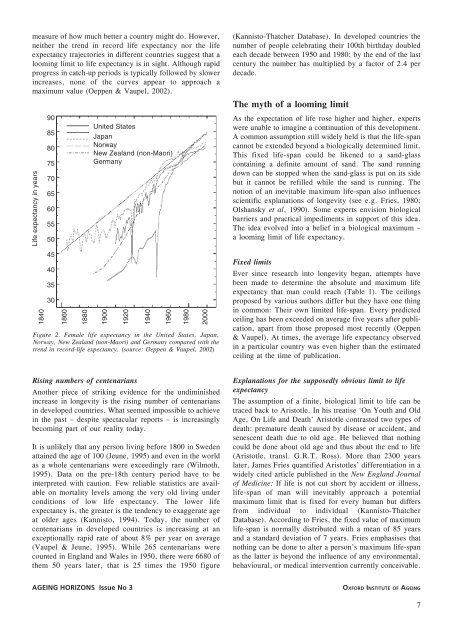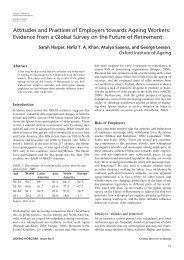Broken limits to life expectancy - by Vaupel and v.Kistowksi
Broken limits to life expectancy - by Vaupel and v.Kistowksi
Broken limits to life expectancy - by Vaupel and v.Kistowksi
Create successful ePaper yourself
Turn your PDF publications into a flip-book with our unique Google optimized e-Paper software.
measure of how much better a country might do. However,<br />
neither the trend in record <strong>life</strong> <strong>expectancy</strong> nor the <strong>life</strong><br />
<strong>expectancy</strong> trajec<strong>to</strong>ries in different countries suggest that a<br />
looming limit <strong>to</strong> <strong>life</strong> <strong>expectancy</strong> is in sight. Although rapid<br />
progress in catch-up periods is typically followed <strong>by</strong> slower<br />
increases, none of the curves appear <strong>to</strong> approach a<br />
maximum value (Oeppen & <strong>Vaupel</strong>, 2002).<br />
Life <strong>expectancy</strong> in years<br />
1840<br />
90<br />
85<br />
80<br />
75<br />
70<br />
65<br />
60<br />
55<br />
50<br />
45<br />
40<br />
35<br />
30<br />
1860<br />
1880<br />
United States<br />
Japan<br />
Norway<br />
New Zeal<strong>and</strong> (non-Maori)<br />
Germany<br />
1900<br />
1920<br />
1940<br />
1960<br />
1980<br />
2000<br />
Figure 2. Female <strong>life</strong> <strong>expectancy</strong> in the United States, Japan,<br />
Norway, New Zeal<strong>and</strong> (non-Maori) <strong>and</strong> Germany compared with the<br />
trend in record-<strong>life</strong> <strong>expectancy</strong>. (source: Oeppen & <strong>Vaupel</strong>, 2002)<br />
(Kannis<strong>to</strong>-Thatcher Database). In developed countries the<br />
number of people celebrating their 100th birthday doubled<br />
each decade between 1950 <strong>and</strong> 1980; <strong>by</strong> the end of the last<br />
century the number has multiplied <strong>by</strong> a fac<strong>to</strong>r of 2.4 per<br />
decade.<br />
The myth of a looming limit<br />
As the expectation of <strong>life</strong> rose higher <strong>and</strong> higher, experts<br />
were unable <strong>to</strong> imagine a continuation of this development.<br />
A common assumption still widely held is that the <strong>life</strong>-span<br />
cannot be extended beyond a biologically determined limit.<br />
This fixed <strong>life</strong>-span could be likened <strong>to</strong> a s<strong>and</strong>-glass<br />
containing a definite amount of s<strong>and</strong>. The s<strong>and</strong> running<br />
down can be s<strong>to</strong>pped when the s<strong>and</strong>-glass is put on its side<br />
but it cannot be refilled while the s<strong>and</strong> is running. The<br />
notion of an inevitable maximum <strong>life</strong>-span also influences<br />
scientific explanations of longevity (see e.g. Fries, 1980;<br />
Olshansky et al, 1990). Some experts envision biological<br />
barriers <strong>and</strong> practical impediments in support of this idea.<br />
The idea evolved in<strong>to</strong> a belief in a biological maximum –<br />
a looming limit of <strong>life</strong> <strong>expectancy</strong>.<br />
Fixed <strong>limits</strong><br />
Ever since research in<strong>to</strong> longevity began, attempts have<br />
been made <strong>to</strong> determine the absolute <strong>and</strong> maximum <strong>life</strong><br />
<strong>expectancy</strong> that man could reach (Table 1). The ceilings<br />
proposed <strong>by</strong> various authors differ but they have one thing<br />
in common: Their own limited <strong>life</strong>-span. Every predicted<br />
ceiling has been exceeded on average five years after publication,<br />
apart from those proposed most recently (Oeppen<br />
& <strong>Vaupel</strong>). At times, the average <strong>life</strong> <strong>expectancy</strong> observed<br />
in a particular country was even higher than the estimated<br />
ceiling at the time of publication.<br />
Rising numbers of centenarians<br />
Another piece of striking evidence for the undiminished<br />
increase in longevity is the rising number of centenarians<br />
in developed countries. What seemed impossible <strong>to</strong> achieve<br />
in the past – despite spectacular reports – is increasingly<br />
becoming part of our reality <strong>to</strong>day.<br />
It is unlikely that any person living before 1800 in Sweden<br />
attained the age of 100 (Jeune, 1995) <strong>and</strong> even in the world<br />
as a whole centenarians were exceedingly rare (Wilmoth,<br />
1995). Data on the pre-18th century period have <strong>to</strong> be<br />
interpreted with caution. Few reliable statistics are available<br />
on mortality levels among the very old living under<br />
conditions of low <strong>life</strong> <strong>expectancy</strong>. The lower <strong>life</strong><br />
<strong>expectancy</strong> is, the greater is the tendency <strong>to</strong> exaggerate age<br />
at older ages (Kannis<strong>to</strong>, 1994). Today, the number of<br />
centenarians in developed countries is increasing at an<br />
exceptionally rapid rate of about 8% per year on average<br />
(<strong>Vaupel</strong> & Jeune, 1995). While 265 centenarians were<br />
counted in Engl<strong>and</strong> <strong>and</strong> Wales in 1950, there were 6680 of<br />
them 50 years later, that is 25 times the 1950 figure<br />
Explanations for the supposedly obvious limit <strong>to</strong> <strong>life</strong><br />
<strong>expectancy</strong><br />
The assumption of a finite, biological limit <strong>to</strong> <strong>life</strong> can be<br />
traced back <strong>to</strong> Aris<strong>to</strong>tle. In his treatise ‘On Youth <strong>and</strong> Old<br />
Age, On Life <strong>and</strong> Death’ Aris<strong>to</strong>tle contrasted two types of<br />
death: premature death caused <strong>by</strong> disease or accident, <strong>and</strong><br />
senescent death due <strong>to</strong> old age. He believed that nothing<br />
could be done about old age <strong>and</strong> thus about the end <strong>to</strong> <strong>life</strong><br />
(Aris<strong>to</strong>tle, transl. G.R.T. Ross). More than 2300 years<br />
later, James Fries quantified Aris<strong>to</strong>tles’ differentiation in a<br />
widely cited article published in the New Engl<strong>and</strong> Journal<br />
of Medicine: If <strong>life</strong> is not cut short <strong>by</strong> accident or illness,<br />
<strong>life</strong>-span of man will inevitably approach a potential<br />
maximum limit that is fixed for every human but differs<br />
from individual <strong>to</strong> individual (Kannis<strong>to</strong>-Thatcher<br />
Database). According <strong>to</strong> Fries, the fixed value of maximum<br />
<strong>life</strong>-span is normally distributed with a mean of 85 years<br />
<strong>and</strong> a st<strong>and</strong>ard deviation of 7 years. Fries emphasises that<br />
nothing can be done <strong>to</strong> alter a person’s maximum <strong>life</strong>-span<br />
as the latter is beyond the influence of any environmental,<br />
behavioural, or medical intervention currently conceivable.<br />
AGEING HORIZONS Issue No 3<br />
OXFORD INSTITUTE OF AGEING<br />
7





![ORAL PRESENTATIONS [pdf] - Oxford Institute of Ageing](https://img.yumpu.com/37918222/1/184x260/oral-presentations-pdf-oxford-institute-of-ageing.jpg?quality=85)




